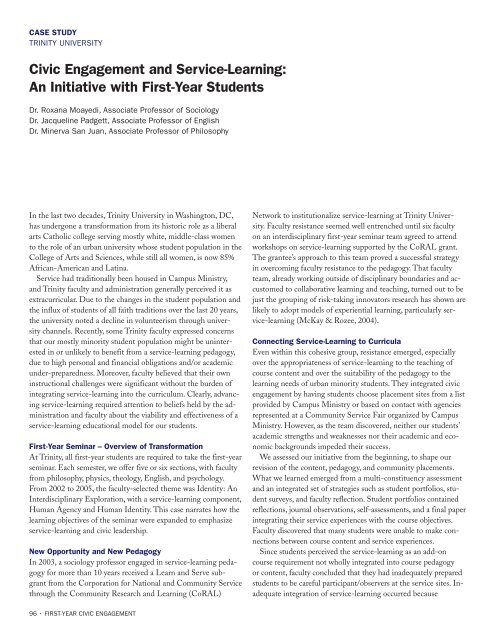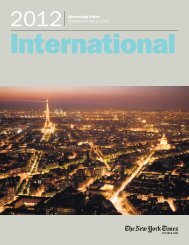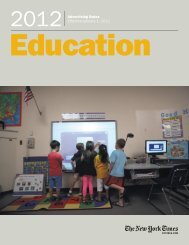CASE STUDYTRINITY UNIVERSITY<strong>Civic</strong> <strong>Engagement</strong> and Service-Learning:An Initiative with <strong>First</strong>-<strong>Year</strong> StudentsDr. Roxana Moayedi, Associate Professor of SociologyDr. Jacqueline Padgett, Associate Professor of EnglishDr. Minerva San Juan, Associate Professor of PhilosophyIn the last two decades, Trinity University in Washington, DC,has undergone a trans<strong>for</strong>mation from its historic role as a liberalarts Catholic college serving mostly white, middle-class womento the role of an urban university whose student population in the<strong>College</strong> of Arts and Sciences, while still all women, is now 85%African-American and Latina.Service had traditionally been housed in Campus Ministry,and Trinity faculty and administration generally perceived it asextracurricular. Due to the changes in the student population andthe influx of students of all faith traditions over the last 20 years,the university noted a decline in volunteerism through universitychannels. Recently, some Trinity faculty expressed concernsthat our mostly minority student population might be uninterestedin or unlikely to benefit from a service-learning pedagogy,due to high personal and financial obligations and/or academicunder-preparedness. Moreover, faculty believed that their owninstructional challenges were significant without the burden ofintegrating service-learning into the curriculum. Clearly, advancingservice-learning required attention to beliefs held by the administrationand faculty about the viability and effectiveness of aservice-learning educational model <strong>for</strong> our students.<strong>First</strong>-<strong>Year</strong> Seminar – Overview of Trans<strong>for</strong>mationAt Trinity, all first-year students are required to take the first-yearseminar. Each semester, we offer five or six sections, with facultyfrom philosophy, physics, theology, English, and psychology.From 2002 to 2005, the faculty-selected theme was Identity: AnInterdisciplinary Exploration, with a service-learning component,Human Agency and Human Identity. This case narrates how thelearning objectives of the seminar were expanded to emphasizeservice-learning and civic leadership.New Opportunity and New PedagogyIn 2003, a sociology professor engaged in service-learning pedagogy<strong>for</strong> more than 10 years received a Learn and Serve subgrantfrom the Corporation <strong>for</strong> National and Community Servicethrough the Community Research and Learning (CoRAL)Network to institutionalize service-learning at Trinity University.Faculty resistance seemed well entrenched until six facultyon an interdisciplinary first-year seminar team agreed to attendworkshops on service-learning supported by the CoRAL grant.The grantee’s approach to this team proved a successful strategyin overcoming faculty resistance to the pedagogy. That facultyteam, already working outside of disciplinary boundaries and accustomedto collaborative learning and teaching, turned out to bejust the grouping of risk-taking innovators research has shown arelikely to adopt models of experiential learning, particularly service-learning(McKay & Rozee, 2004).Connecting Service-Learning to CurriculaEven within this cohesive group, resistance emerged, especiallyover the appropriateness of service-learning to the teaching ofcourse content and over the suitability of the pedagogy to thelearning needs of urban minority students. They integrated civicengagement by having students choose placement sites from a listprovided by Campus Ministry or based on contact with agenciesrepresented at a Community Service Fair organized by CampusMinistry. However, as the team discovered, neither our students’academic strengths and weaknesses nor their academic and economicbackgrounds impeded their success.We assessed our initiative from the beginning, to shape ourrevision of the content, pedagogy, and community placements.What we learned emerged from a multi-constituency assessmentand an integrated set of strategies such as student portfolios, studentsurveys, and faculty reflection. Student portfolios containedreflections, journal observations, self-assessments, and a final paperintegrating their service experiences with the course objectives.Faculty discovered that many students were unable to make connectionsbetween course content and service experiences.Since students perceived the service-learning as an add-oncourse requirement not wholly integrated into course pedagogyor content, faculty concluded that they had inadequately preparedstudents to be careful participant/observers at the service sites. Inadequateintegration of service-learning occurred because
(1) faculty spent little time modeling the integration of servicelearninginto courses, placing emphasis on disciplinary contentwhile crowding out reflection on service-learning; and (2) communityplacements hindered integration because the sites chosendid not necessarily fit the course design. Students’ selection ofcommunity placements from the list in the Campus Ministryoffice had dispersed their placements across the District’s metropolitanarea in activities that generally did not coincide clearlywith or enhance the course materials.The following year (2004-05), to remedy these problems andto bolster the learning outcomes, faculty implemented structuraland pedagogical changes. Each seminar section was paired witha specific agency whose aims dovetailed with course objectives.Community partners were a resource/drop-in center <strong>for</strong> expectingparents and families with young children; two organizationsthat provide housing and services to homeless families or women;an after-school program; and an organization that links schools,families, and the community to support quality education. Students’shared service experience enhanced their reflection in class.The community service requirement was increased from 12 to20 hours to give students sufficient exposure to the agency andits clientele, and, consequently, enough time <strong>for</strong> learning on-site.Faculty set aside class time be<strong>for</strong>e the service to introduce servicelearning,underline its pedagogical rationale, and prepare studentsto construct their service experiences in terms of learning. Facultyaccepted the necessity of streamlining course content to fosteracquisition of course objectives through service-learning.AssessmentFaculty engaged in assessment in collaboration with the servicelearningstaff in order to understand outcomes. Their reviewof student portfolios provided one means of assessment (andeffected changes described above); student surveys providedanother. Since fall 2004, students enrolled in first-year seminarshave participated in the CoRAL Network pre- and post-surveys,measuring their expectations of service-learning, and its effect onwriting and critical thinking skills and their grasp on course content.Students’ community-based experiences generally confirmedand exceeded their positive expectations (Table 1).Student surveys rein<strong>for</strong>ce the conclusion that communitybasedlearning is most effective when faculty ensure a high-qualitycommunity placement and fully integrate service activitieswith the course material through critical reflection and discussion(Eyler, Giles, Stenson, & Gray, 2001).Recently, the National Survey of Student <strong>Engagement</strong> (NSSE)showed that Trinity’s first-year students scored well above coeducationalpeer institutions on a large number of service-learningand civic engagement indicators. Compared with all other firstyearstudents nationwide who took the NSSE survey in spring2006, Trinity students had a higher rate of participation in coursebasedservice-learning projects and were more likely to have votedin national and state elections. They reported significantly strongerexperience in developing personal values and ethics, contributingto their community’s welfare, and understanding diversity.The first-year student initiative in incorporating service-learningto promote civic engagement succeeded in developing a cadreof professors willing to employ service-learning pedagogy and inenhancing the learning experiences of Trinity University students.Supplemental MaterialsPlease refer to our service-learning link to view our CommunityPartner Manual and Student Manual: http://www.trinitydc.edu/academics/service_learning/ReferencesEyler, J. S., Giles, D. E., Jr., Stenson, C. M., & Gray, C. J. (2001).At a glance: What we know about the effects of service-learningon college students, faculty, institutions and communities,1993-2000. (3rd ed.). www.compact.org/ resource/aag.pdf.Retrieved September 2, 2006, fromhttp://www.compact.org/resource/aag.pdf.McKay, V. & Rozee, P. (2004). Characteristics of faculty whoadopt community service learning pedagogy. MichiganJournal of Community Service Learning 10(2), 21-33.Table 1Students’ Expectations and Experiences of Community-Based Learning, Fall 2004 and Spring 2005Fall 2004 Spring 2005The community-based learning will. . .Pre-Survey( Post-Survey( Pre-Survey( Post-Survey( = 42)Develop my critical thinking skills Enhance my academic experiences Help me understand course readings and content Note: Percentage of students who agreed or strongly agreed on pre- and post-surveys reported.
- Page 1:
First-Year Civic Engagement:Sound F
- Page 5 and 6:
CONTENTSivPrefaceMartha J. LaBare,
- Page 7:
Zlotkowski, Edward, ed. (2002). Ser
- Page 10 and 11:
we had the “great flood” of the
- Page 12 and 13:
Requiring civic engagement demonstr
- Page 14 and 15:
The preparation of citizens was one
- Page 16 and 17:
preparation. At its heart, this wor
- Page 18 and 19:
in it of particular interest to tho
- Page 20 and 21:
often in tension. Political partici
- Page 22 and 23:
educating students for active citiz
- Page 24 and 25:
CHAPTER 4Civic Learning: Aligning P
- Page 26 and 27:
Faces/Phases of CitizenshipFace/Pha
- Page 28 and 29:
ecome more informed and participate
- Page 30 and 31:
ReferencesAstin, A.W., Vogelgesang,
- Page 32 and 33:
photography techniques to inmates a
- Page 34 and 35:
CHAPTER 8Action Steps to Move theFi
- Page 36 and 37:
ConclusionI wish to be very clear t
- Page 38 and 39:
CASE STUDYALLEGHENY COLLEGECivic En
- Page 40 and 41:
CASE STUDYANTIOCH COLLEGECivic Enga
- Page 42 and 43:
CASE STUDYCALIFORNIA STATE UNIVERSI
- Page 44 and 45:
CASE STUDYCALIFORNIA STATE UNIVERSI
- Page 46 and 47:
CASE STUDYCHANDLER-GILBERT COMMUNIT
- Page 48 and 49:
CGCC Global Engagement:http://www.c
- Page 50 and 51:
student blog in which students are
- Page 52 and 53:
CASE STUDYTHE COLLEGE OF NEW JERSEY
- Page 54 and 55: I. Contributors’ Names and Contac
- Page 56 and 57: opportunities of CSU students and C
- Page 58 and 59: needs, and expectations of the serv
- Page 60 and 61: Although Times Talk began in Septem
- Page 62 and 63: CASE STUDYFRANKLIN PIERCE UNIVERSIT
- Page 64 and 65: We now have a comprehensive assessm
- Page 66 and 67: Another major assignment for this c
- Page 68 and 69: CASE STUDYHAMPDEN-SYDNEY COLLEGELiv
- Page 70 and 71: I. Contributors’ Names and Contac
- Page 72 and 73: Qualitative assessment begins with
- Page 74 and 75: 3. Lessons in Democracy. The IUPUI
- Page 76 and 77: CASE STUDYLEHIGH UNIVERSITYJudging
- Page 78 and 79: CASE STUDYMARS HILL COLLEGELifeWork
- Page 80 and 81: CASE STUDYMERCER UNIVERSITYInterdis
- Page 82 and 83: CASE STUDYMICHIGAN STATE UNIVERSITY
- Page 84 and 85: CASE STUDYPACE UNIVERSITYCivic Enga
- Page 86 and 87: Susan-Feather GannonProfessor, Tech
- Page 88 and 89: AssessmentData were gathered from s
- Page 90 and 91: CASE STUDYPITZER COLLEGEThe Communi
- Page 92 and 93: from people different from themselv
- Page 94 and 95: Table 1Summary of the Major Outcome
- Page 96 and 97: engaged stewards of the environment
- Page 98 and 99: HIV-positive individuals. They also
- Page 100 and 101: Students were then equipped to eval
- Page 102 and 103: the World Affairs Council (WAC), in
- Page 106 and 107: I. Contributors’ Names and Contac
- Page 108 and 109: in the organization of health care
- Page 110 and 111: study and a series of retreats as p
- Page 112 and 113: ing based opportunities. Both semes
- Page 114 and 115: engaging first-year students and st
- Page 116 and 117: CASE STUDYWEBER STATE UNIVERSITY CO







